Arlo Ray Mathison
May 24, 2013
Since I'll probably be visiting the Normandy American Cemetery in Colleville-sur-Mer every year, I thought I might adopt an American war grave there too. At first I thought that there won't be a grave available anymore, but that was not right. Many seemed to be free. I immediately sent a request and a contribution to Normandy and a few days later I received an e-mail in which Arlo R. Mathison's grave was appointed to me.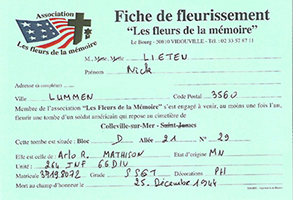 |
Before the war
Arlo was born on October 7, 1919 in Cherry Grove, Forestville Township, Fillmore County, USA. Arlo was the son of Charles J. Mathison and Maude Ann Terbeest. He had three sisters, Elener M. (Mathison) Butler, Eunice A. (Mathison) Treese and Armida R. (Mathison) James. He also had two brothers, Paul E. Mathison and Curtis J. Mathison.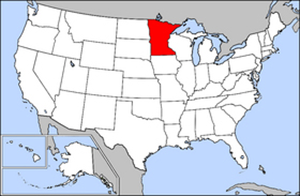 Minnesota, USA |
 Fillmore County, Minnesota |
Arlo's youth was spent much as any youth, coming from, and growing up in a good home, where early and sustained religious training and the church played an important part. His faith in Jesus Christ as a personal Saviour stood him in good stead through all his brief but full life.
He was a member of the Cherry Grove Evangelical Church until 1942 when he transferred his membership to Grace Evangelical Church of Spring Valley. He was an outstanding young man of his community. He was superintendent of the Cherry Grove Sunday School for a time, and served as a member of the Quarterly Conference, and was active in other church work. He gained recognition in his community as President of the Fillmore County Council of Religious Education. He was a graduate of Spring Valley High School Class of 1937, and attended Western Union College in 1937-38.
In August of 1939 he became an employee of the First National Bank of Spring Valley and worked there as a junior banker until he was inducted into the Army.
On August 14, 1941 he married Dorothy Utzinger in Racine, Minnesota and established a home in Spring Valley. They have two children, Charles A. and Karen E.
Arlo and Dorothy started dating when they were juniors in High School. They were engaged on Christmas in 1938. They married in August 1941, together with Dorothy's sister Helen and her fiancee Duane. They were warned that they shouldn't have a double wedding because something bad would happen to one of the couples.
Arlo left for training on the day of birth of his son, June 10, 1942. He got to hold his son for a little while before the sad parting. Dorothy was 8 months pregnant of her 2nd child when she got the news of Arlo's death on January 14, 1945.
In the army
Arlo was inducted into the Army, June 5th, 1942 and trained in the field artillery of the 81st Wildcat Division and was a supply Sergeant in the 87th Acorn Division. This meant he had to make sure there was equipment and deliveries in his unit.In January 1944 he transferred into the Army Air Corps and qualified as a pilot, bombadier or navigator. Pilot training was discontinued and he was sent to the Infantry and trained with the 66th Panther Division at Camp Rucker in Alabama.
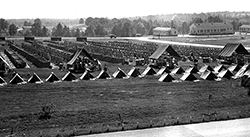
Camp Rucker, Alabama |
He was sent overseas with his division in November of 1944. He spent about a month in England and was privileged to spend several hours with his sisters in London.
Before the division was sent overseas, they were at the army barracks in Piddlehinton, Dorset.
Death of Arlo Mathison
On December 24, 1944. Arlo R. Mathison and his mates were on the USS Leopoldville (built in Hoboken, Belgium) which was taking them from Southampton to Cherbourg. On board were reinforcements of the 262nd and 264th Infantry Regiment of the 66th Infantry Division, heading for the Battle of the Bulge in Belgium.At 17h54, when the ship was about 5,5 miles from Cherbourg, the German U-boat U-486 fired a torpedo on the ship. It struck the Leopoldville on the starboard side and exploded in the number four hold. Compartments E-4, F-4 and G-4 were flooded, stairways were blown away. There were about 300 men in those compartmens and only few men managed to escape to the higher decks. The men in the other parts of the ship who felt the blow began to make their way up to the deck. Despite the blow, they remained calm and disciplined. When they got on deck, they lined up in formation and waited for instructions.
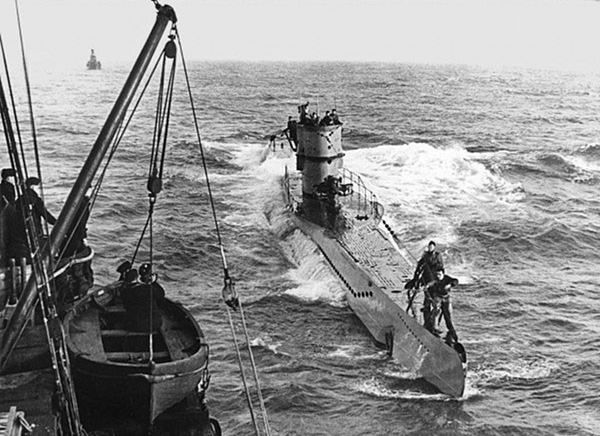
U-486 |
One of the ships that joined the Leopoldville on it's journey to France was the HMS Brilliant. The Brilliant signaled the Leopoldville to drop their anchor and so did Captain Limbor. He also ordered all essential crew to abandon the ship. It wasn't clear yet that the ship was sinking, but the ship's crew taking the lifeboats and rowing away did not give much confidence to the massed men standing on the deck.
The HMS Brilliant had to send a signal to Portsmouth instead of Cherbourg because the US forces in France were tuned to a different radio frequency than the one uses by the British, and so they could not read the British code. Portsmouth then had to call to Cherbourg, but this call was delayed for nearly an hour for unknown reasons.
Another reason there was a delay in the rescue, was the failure of any ship of the convoy to blinker signals from shore. The Americans that were at Fort l'Ouest in Cherbourg immediately noticed that the convoy had stopped. They saw that one of the ships was drifting toward a minefield. However, repeated attempts from the Fort to signal the Leopoldville and the convoy with blinkers, brought no answer until 18h25, when Brilliant signaled: "Leopoldville hit, need assistance". The Fort blinkered back inquiring as to the kind of assistance needed, but received no reply.
And another reason for the delay was the Christmas holiday itself. There were hundreds of ships in the harbor at Cherbourg that could have served as rescue craft, but they were all lightly manned due to the holiday and all had cold engines. All posts on the base were minimally staffed due to attendance of holiday parties, a situation that significantly slowed communications, decisions and orders.
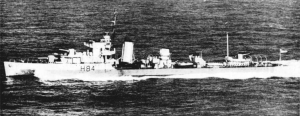
HMS Brilliant |
When the majority of the crew had abandoned the ship on captain Limbor's order, the Brilliant approached and maneuvered next to the Leopoldville. This was not easy because there were empty lifeboats floating in the water between the two ships. The Brilliant had to crush the lifeboats so it could get closer to the Leopoldville. Because of the waves, the ships were bashed together and drawn apart again. Hundreds of men tried to jump, climb... from the Leopoldville to the Brilliant. Most of them succeeded, others miscalculated their jump and fell in the water where they were crushed between the two ships, a horrific sight. About 500 men were rescued by the Brilliant that now had to pull away from the Leopoldville.
The Brilliant now headed for shore to unload the rescued men and saw rescue crafts heading towards the Leopoldville finally. It was now 19h20. They were now taking men off the ship but it went very slow. There were still about 1200 soldiers on board at around 20h00, of whom 25 Belgians and 10 British officers. They were ordered to abandon ship by their captain Limbor. About 30 minutes later there were two explosions in the ship. Hatch covers blew off and some men fell into the water. The ship began to heel sideways as well as sinking stern down. The men that were still on the deck were forced to jump, crawl or step in the water.
The water was 48 degrees. Hundreds of men were struggling to keep their heads above water, but it was hard because they all were still wearing their heavy clothing or gear. Some men were killed instantly by the drop into the water because they had not been instructed how to safely enter the water wearing their lifejackets and helmets. Many men quickly drowned or became unconscious. Some that were still strong, determined or lucky were able to find wreckage to hold on to and to survive.
The rescue ships were now taking survivors as well as bodies aboard. Because of the freezing temperatures it was sometimes hard to tell the difference. Bodies that are thought to be dead men, were given a cursory check by medics ashore. Then the bodies were all put together on the pier in Cherbourg.
Captain Limbor went down with his ship. One Belgian and three Congolese crewmen died. From 2.235 men on board, about 515 went down with the ship, 248 died drowning, cooling or injury. It is not clear how Arlo Mathison died exactly, probably he was one of the men that drowned in the cold water.
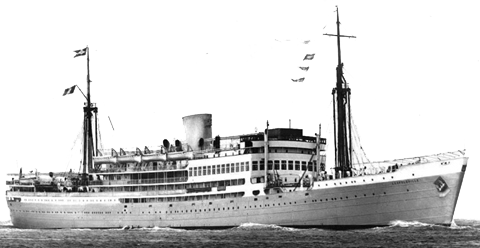
USS Leopoldville |
Arlo was buried at the Normandy American Cemetery in Colleville-sur-Mer, France on March 17, 1949.
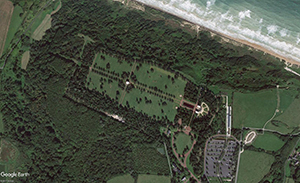
Normandy American cemetery, Colleville-sur-Mer, France |
This poem was dedicated to his family:
"God has not promised skies always blue.
Flower-strewn pathways all our lives thru.
God has not promised sun without rain,
Joy without sorrow, peace without pain.
But God has promised strength for the day,
Rest for the laborer, light for the way,
Grace for the trial, help from above,
Unfailing patience, undying love."
"Who creates, shall sustain -- who gave life shall renew...
Who hath promised, shall keep...
It is He ever friend and Preserver,
O Soul; The Lord is His name!"
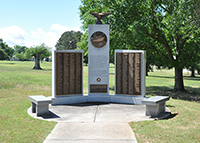
USS Leopoldville memorial, Fort Benning |

USS Leopoldville memorial, Fort Benning |
264th Infantry Regiment, 66th Infantry Division
 264th Infantry Regiment |
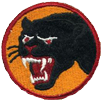 66th Infantry Division |
 Staff Sergeant |
The 66th Infantry Division was a unit of the United States army during World War II. The division was activated on April 15, 1943 and trained at Camp Blanding in Florida and was later transferred to Camp Robinson in Arkansas and then later to Camp Rucker in Alabama. They were shipped to England on November 26, 1944.
The Division's main role in World War II was containing and eliminating the remaining pockets of German soldiers in Northern France. Three regiments arrived in Dorchester on the 26th. They trained and prepared for deployment until December 24, 1944. That day they were transferred to Southampton to cross the Channel to Cherbourg. They were transported by two Belgian vessels: the Cheshire and the Leopoldville.
Only five miles from Cherbourg the dramatic event with the Leopoldville occurred. The US Navy announced later that the sinking of the Leopoldville was the second-largest loss of life from the sinking of a troop transport shin in the entire European Theater.
The 66th relieved the 94th of control of the Brittany-Loire area on December 29, 1944 and collaborated with French forces as well. The division carried out its objective by harassing German installations, limited objective attacks and running reconnaissance missions to gather intelligence. The use of artillery shelling many German positions also played a major part in the advancement of the 66th through the region.
A heavy German attack near La Croix was repulsed on April 16, 1945 and several strongly fortified enemy positions were taken from April 19 to April 29 in a series of counterattacks. These battles played a vital role in ending the Nazi occupation of Northern France. The remaining Nazi soldiers surrendered to the 66th Officers and French officials in a small cafe near Cordemais on May 8, 1945.
The 66th made a 700 mile trek into Germany where they occupied 2400 square miles of territory and the city of Koblenz. As a security force the division was charged with establishment of a military government and control of all German affairs. Tasks included the dischargement of prisoners of war, inventorying of ammunition and supplies, and organizing civilians.
After spending time in Germany, the 66th returned to the French coast to aid with the allied withdrawal from the European Theater. During this time the division was changed by the beginning of the inactivation process, until it returned to the US and formally inactivated, sailing for home October 27, 1945.
In total the division suffered 1.452 battle casualties, 795 KIA (including the Leopoldville disaster), 636 wounded in action and 21 prisoners of war.
Contact
When I received message that I had adopted Arlo's grave, I started looking for information on the internet. I mostly found information on how Arlo died because he died in a well-known disaster..When I checked the mundia.com website I found his ancestry tree and got into contact with Tim James who provided me a lot of information about Arlo Mathison. Tim is the grandson of Armida, Arlo's sister. Thanks Tim!
By now I have met a few more relatives through the internet. I had the honor to receive and send e-mails with Arlo's daughter Karen, who never knew her father as she was born shortly after the disaster with the Leopoldville.
Personal information
Staff Sergeant, U.S. ArmyService # 37198072
264th Infantry Regiment, 66th Infantry Division, B Company
Entered service from Minnesota on June 5, 1942
Born: October 7, 1919
Hometown: Cherry Grove, Fillmore County, Minnesota
Died: December 25, 1944 near the coast of Cherbourg, France
Status: killed in action (KIA)
Buried: Plot D, row 21, grave 29, Normandy American Cemetery, Colleville-sur-Mer, France
Awards: Purple Heart
 Purple Heart |
Family
Wife: Dorothy F. Utzinger (1919-2013)
Children: Charles A. (1942-current) and Karen E. (1945-current)
Father: Charles J. Mathison (1887-1969)
Mother: Maude Ann Terbeest (1889-1983)
Brothers: Paul E. (1928-current) and Curtis J. (1930-current)
Sisters: Elener M. (1913-1993), Eunice A. (1914-1995) and Armida R. (1921-current)
More pictures
Arlo Mathison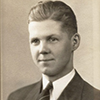
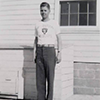
Family
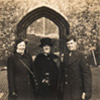
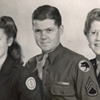
Grave
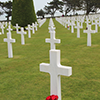
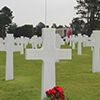
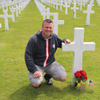
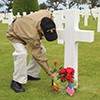
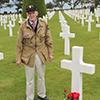
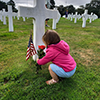
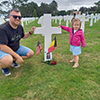
Sources
Any information you can provide me about this soldier, can be mailed to me (nicklieten at hotmail.com). Thank you!